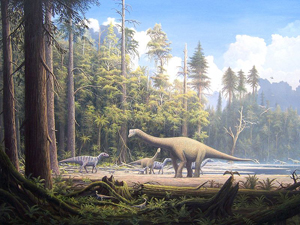
But by night, scientists sift the newly dug up earth for treasure from a barely conceivable past: fossils, from the first age of dinosaurs.
Developer K. Hovnanian Homes will build condominiums on the privately owned site. But scientists and history buffs have petitioned officials to absorb part of the quarry into a park, thus preserving a sandstone wall imprinted with dinosaur tracks predating an ancient mass extinction and showing effects of climate change.
But time’s running out as the county review takes its course. And now, with tractors atop the cliff already having pushed a shroud of soil over the wall, those scientists have turned their efforts to salvaging what fossils they can for museum display.
“It’s really bulldozed over,” said John McCauley, an amateur paleontologist and museum founder who’s collected more than 2,000 signatures on a petition to incorporate the wall into the adjacent Rifle Camp Park. “The layers are intact, but they’re about 10 to 15 feet deep under soil now.”
Preserved in the wall are the footprints of dinosaurs and other life, plus evidence of the conditions following the Triassic-Jurassic wipeout of half of the planet’s life forms amid volcanic activity about 200 million years ago.
“The Triassic extinction layer is just below the lava in the sandstone, and the dawn of the Jurassic period is there, with the most species at that layer of any quarry in New Jersey,” said Chris Laskowich of Woodland Park, a former science teacher at Paterson’s Eastside High School.
There are dinosaur tracks throughout the Newark Basin, but this is “the only place that remains in eastern North America where the geological context of those footprints can be seen,” said Paul Olsen, a Columbia University professor who has extensively researched the site. In laymen’s terms, that means it’s the only such site not shattered by development.
The fossils also include other animals’ tracks and even rain patterns. Water ripples also are visible in the sandstone, indicating a lake once existed, said Gary Vecchiarelli, research associate at the State Museum’s Bureau of Natural History and a geoscience student at New Jersey City University.
Layers of sediment show the lake dried up and then returned, Laskowich said. There also is a spot where lava “paused and chilled and then started up again.”
Collectively, these natural records show the conditions that sparked the mass extinction: the eruption of giant lava flows coupled with a reversal of Earth’s magnetic field, Olsen said.
The eruptions likely emitted “huge amounts” of carbon dioxide that “wiped out about 50 percent of the groups of living organisms, and it took 20 million years for ecosystems to recover that diversity,” he added. In the current context of climate change, “It certainly bears examination but we can’t examine it if the rock outcrops are covered with concrete.”
McCauley’s petition asks the Passaic County Parks Department to incorporate the wall into adjacent Rifle Camp Park, leaving the rest of the quarry to the condos. County spokesman Keith Furlong said the county received the petition “a few months ago” and that its Planning Board had met with K. Hovnanian executives about ways to preserve the tracks and fossils.
But a spokesman for K. Hovnanian said the developer will proceed as planned.
“We’re bringing this site into conformance with the rest of the neighborhood,” said spokesman Doug Fenichel. “We’re creating a lot of good homes and a lot of economic activity. This is a great story of taking an industrial operation that was in a residential area and reclaiming it for residential use.”
The scientists said they do not oppose developing the quarry so long as the fossil wall is left intact. “If they were to leave the red rock exposed but not excavatable, that would still be very valuable,” Olsen said. “But if they put a wall of cement on top of it, that would, for all practical purposes, eliminate the scientific value of the site.”
Copyright 2010 Associated Press. All rights reserved. This material may not be published, broadcast, rewritten, or redistributed.
AP-ES-08-21-10 1233EDT


